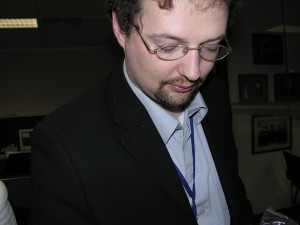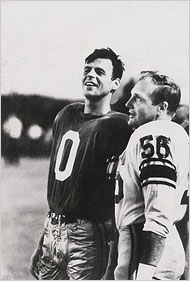
By Jim Boyce
–
The book Paper Lion recounts the experience of George Plimpton who tried out for the Detroit Lions football team. The climax comes after three weeks of training when Plimpton is sent into a practice game to quarterback five plays. He fails miserably – he drops the ball on one play, overthrows a receiver on another, and slips and falls on yet a third. Due to the speed and complexity of the game, what seemed manageable to a fan in the stands turns out to be profoundly difficult on the field, and he returns defeated to the bench.
I kind of had a similar experience earlier this week when I sat on a tasting panel with three experts in Shanghai and tried 340 Bordeaux wines over two and a half days. I had no illusions that the tasting would be easy, but I did relate to Plimpton’s “regular guy in a professional setting†scenario.
I have joined about a half-dozen tasting panels, most of them organized by wine magazines. They typically covered 20 or 30 wines and we had ample time to sniff, sip, and score. The Shanghai tasting, however, featured far more wines and proceeded – at least to me – at warp speed.
I will write later posts about the wines we tasted and the pros and cons of this system, but first let me explain the two major challenges I found. And for brevity’s sake, I’ll make three points about each.
–
The body
– My gums and cheeks often felt like they were glued together, due to the drying sensation from the tannins in many of the 270 red wines we tasted. It would take 10 seconds or more for enough saliva to form and “unglue†them. Imagine the sensation of sucking on a lemon, except much drier and much longer lasting. It’s not pleasant and it happened 40 or 50 times.
– My teeth ached after finishing the whites, due – said a co-taster – to the acidity. And with the red wines, my teeth turned purple. Brushing them became painful because my gums had become so sensitive.
– And my brain struggled to keep track of the wines, simply because there were so many. I just gave #142 a score of 12 of 20. Hmm, maybe it is as good as #139, which I scored 13. I better try both again. Retrying these wines simply made my gums and teeth feel worse.
– Interestingly, my nose was the one part of my body that kept up. Right to the end, I could pick up smells, whether chocolate, mint, grass, or blackberries. I also could smell corked wines, which were fortunately few and far between.
The mind
– Experience is invaluable in these types of tastings. If you have a clear idea of what constitutes a score of 12 or 14 or 20, you are going to save a lot of time. I lack that experience. I worried that a wine I scored an 11.5 on a Tuesday afternoon, when I felt tired, might have scored a 13 early on Monday morning when I felt refreshed. This meant re-tasting. Related to this were the different wines styles. Was I giving higher scores to those wines that stood out due to ample fruit or strong aromas, rather than to those that might as good, or better, but more subtle and elegant? Again, more re-tasting…
– Because of this lack of experience, I struggled to keep up to the experts. They might be finishing a flight of eight wines just as I was starting the fifth glass. This added pressure to speed up.
– Finally, experts usually have a broader wine vocabulary and can make quicker and more specific evaluations of what they smell and taste. What I might note as “fruity and earthy“, they might classify as “blackberries, ripe dark plums, and freshly tilled soil with a hint of flint.” They are also more fine-tuned to discern acidity, tannins, body, and so on.
In the end, a TV crew interviewed each of us. The reporter asked me my technique for trying so many wines. I said I drank a lot of water, cleaned my palate with bread, and afterward brushed my teeth – I pulled a toothbrush from my jacket as evidence. I added that I found the number of wines near-overwhelming, but thought the process useful for consumers, though instead of 340, they could get together and try four or eight wines at home. I stand by this: One of the best ways to learn about wine, and about what you like, is to compare and contrast.
Like Plimpton, I left the event feeling a bit defeated, as I had neither enough training nor experience to perform like my fellow tasters. (I should add that they were extremely patient and, even better, fun).
But as a consumer, I felt somewhat victorious. Why? Because it may well be my tastes differ from those of the experts, since we approach wine from entirely different backgrounds, and it affirmed that we should all drink what we like. And one of the best ways to discover what you like is get together with some friends, open a half-dozen bottles of wine, and create your own panel. Trust me, you will enjoy it much more if try them a few – rather than a hundred – at a time.

–
Note: I’ll soon have posts on how the process works at such an event and some of the pros and cons of these types of tastings.
More posts by Jim Boyce
Sign up for the Grape Wall newsletter here. Follow Grape Wall on LinkedIn, Instagram, Facebook and Twitter. And see my sibling sites World Marselan Day, World Baijiu Day and Beijing Boyce. Grape Wall has no advertisers, so if you find the content useful, please help cover the costs via PayPal, WeChat or Alipay. Contact Grape Wall via grapewallofchina (at) gmail.com.
This was great to read. I have never had more than 20 wines at a time. You are truly a champ and while I do not know if I could do it, I am a bit jealous. I love Bordeaux wines.
Really like what you do with this blog Jim, nice job. I think you are more like Vince Papale, by the way :-)